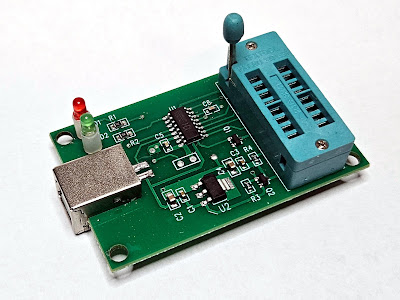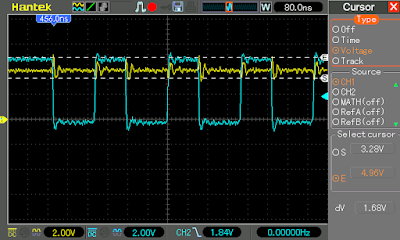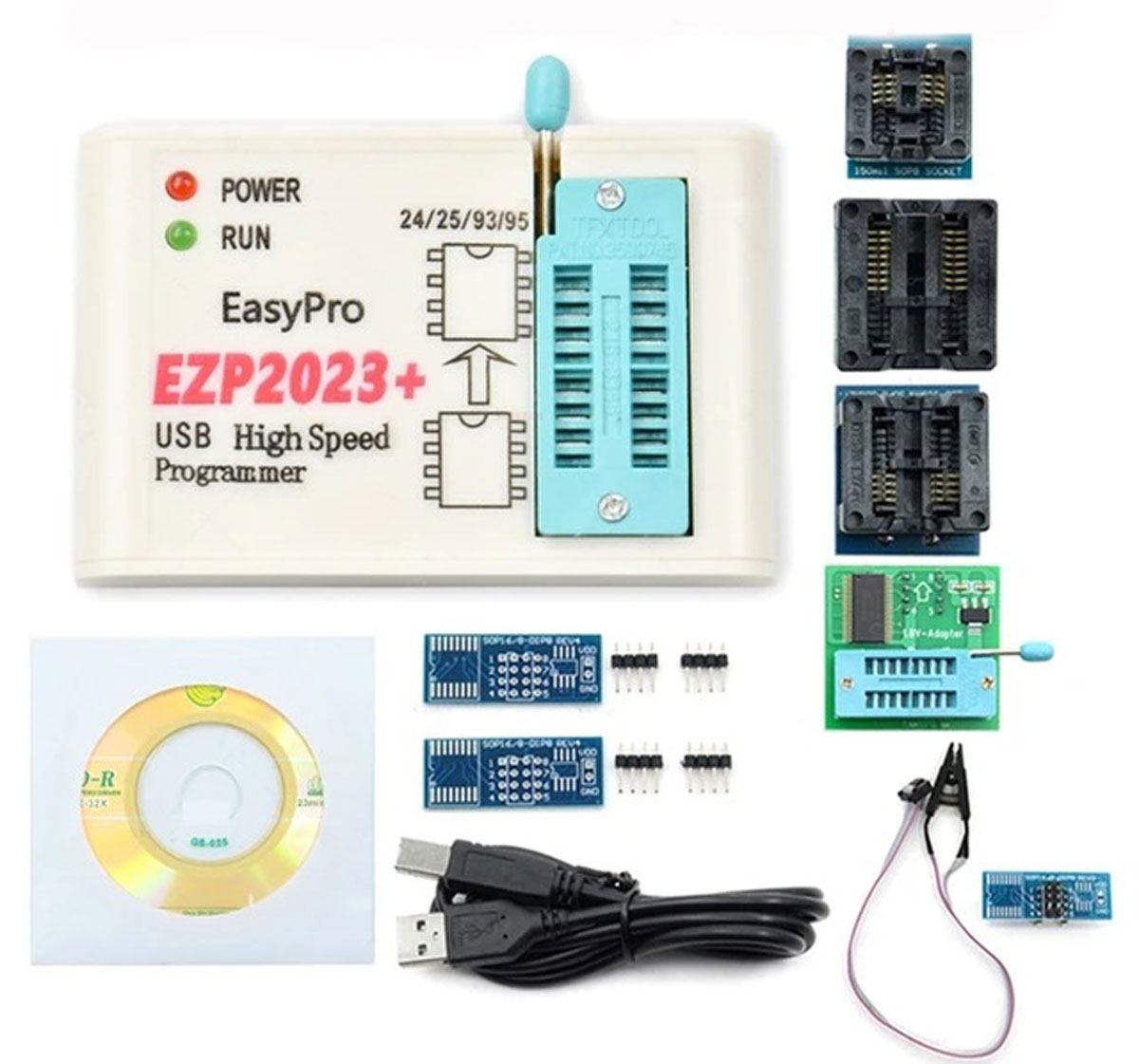EZP2023+ is another programmable cable for SPI, I2C and MicroWire chip memory. It’s not as cheap as the CH341A, but it has some nice features. I got mine from the market with adapters for SMT boxes, SMT adapters and LCD adapters. It comes with a 1.8V adapter card, which is also a good thing. EZP2023+ is considered as the fastest programmer, better than the previous EZP2019. Shortly after I ordered it, I found out that there is also an EZP2025, already available in 2023.
However, the main reason I bought it is because of the installation adapter that can be used on the MiniProgrammer CH341A. Compared to this, the EZP2023+ seems to be a better product because it has a good shield. I received a CD with this programmer (including driver, software and user manual) but they forgot to mention how to put the IC into the programming socket. I want to fully understand how to use it properly, so I take the case apart to examine the electronics.
To my surprise, I quickly discovered that the main IC on the PCB had the WinChipHead logo of Nanjing Qinheng Microelectronics Co., Ltd. on it. This company produces CH340 and CH341. The programmer is based on one of the microcontrollers, CH552G, which is an upgraded E8051 base MCU compatible with MCS51 instructions.

The CH552 supports a system clock frequency of up to 24 MHz and is equipped with 16 KB program ROM, 256 bytes of internal iRAM and 1 KB of internal xRAM to support direct access (DMA). CH552 has an integrated analog-to-digital converter (ADC), touch-sensitive capacitance detection, three timers, signal detector, PWM, two UARTs, SPI, USB device controller, full-speed transceiver, etc.
The PCB has only a few components: the main microcontroller, the USB connector, the voltage regulator, two transistors, two LEDs, a capacitor, and a resistor. Only the top half of the ZIF socket is used (including the handle). The USB connector is held in place on the case (be careful not to bend or break a soldered pin when opening the programmer).
There is an unoccupied jumper between the MCU and voltage regulator U2. Placing a 10k resistor here will put the MCU into programming (download) mode.
Schematic:
The schematic of the EZP2023+ High-speed USB SPI Programmer provides a detailed insight into its internal circuitry and components. The programmer utilizes advanced microcontroller technology to achieve high-speed and reliable SPI programming. The schematic includes components such as voltage regulators, USB interface circuitry, and signal processing elements. It is designed to ensure stable and accurate communication between the programmer and the target SPI device.

This programmer has two 3.3V supplies. The first is the CH552G, which has an internal low-power 3.3V regulator for the USB interface. The USB D programming mode jumper connects to this power output. The other is U2, a constant 1117 linear regulator that powers the ZIF cell.
Both circuits in the ZIF circuit are enabled by MOSFETs. This allows the MCU to decide when to use the device in the socket and what level to use. Q1 (SI2302) pulls the plug from ground to GND. Q2 (SI2305) can bypass voltage regulator U2, so it acts as a switch between 3.3V and 5V.
Alright. It has a power switch and a control line. But what about I/O? Does the programmer suffer from the same problems as the MiniProgrammer CH341A? I had to look at the data and use an oscilloscope to be sure. Well, the data only tells us that the CH552 will determine the voltage above 2.4V even if the power is 5V.

The screenshot above shows that the EZP2023+ has the same fault as the CH341A MiniProgrammer. The yellow probe is connected to the VCC jack, while the cyan probe is connected to the clock signal. The ground of the oscilloscope is connected to the GND terminal. During operation, the memory supply voltage remains at 3.3 V. However, when working, it seems to increase a bit and I don’t understand why (it may not be a real voltage increase since I use long Dupont wires to connect to the oscilloscope probe ; this is also the reason the waveforms look so large).
Here’s the obvious question: can I adjust it to reach 3.3V max? In theory, yes. CH552 can operate efficiently at 3.3V. According to the data, for 3.3V application, V33 pin should be connected to VCC and provide 3.3V.
The EZP2023+ High-speed USB SPI Programmer is a powerful tool for electronics enthusiasts and professionals alike. This programmer provides a convenient and efficient way to program SPI (Serial Peripheral Interface) memory devices using a computer’s USB port. In this article, we will take a detailed look at the overview and schematic of the EZP2023+ High-speed USB SPI Programmer and explore its features and benefits.
Overview:
The EZP2023+ High-speed USB SPI Programmer is designed to offer high-speed SPI programming for a wide range of SPI memory devices. It is compatible with various flash memories, EEPROMs, and other SPI-compatible ICs. The programmer features a USB interface, making it easy to connect to a computer or laptop for programming and configuration. With its compact and portable design, the EZP2023+ programmer is suitable for both professional and hobbyist use.
Features:
The EZP2023+ High-speed USB SPI Programmer offers a range of features to streamline the programming process. One of its key highlights is the high-speed programming capability, which significantly reduces the time required for programming large SPI memory devices. The programmer supports a wide range of SPI clock frequencies, allowing for flexible configuration based on the target device’s specifications. Additionally, it incorporates protection mechanisms to prevent damage to the target device during programming.
Benefits:
For electronics enthusiasts and professionals working with SPI memory devices, the EZP2023+ High-speed USB SPI Programmer offers several notable benefits. Its high-speed programming feature accelerates the programming process, saving valuable time especially when working on projects with tight deadlines. The programmer’s compatibility with various SPI memory devices makes it a versatile tool for a diverse range of applications. Furthermore, its USB interface eliminates the need for additional power sources, enhancing convenience and portability.
Conclusion,
the EZP2023+ High-speed USB SPI Programmer is a valuable tool for anyone working with SPI memory devices. Its high-speed programming capability, compatibility with various SPI devices, and convenient USB interface make it a versatile and efficient solution. Whether you are a professional embedded system engineer or a hobbyist working on electronics projects, the EZP2023+ programmer is a reliable choice for SPI programming requirements.

